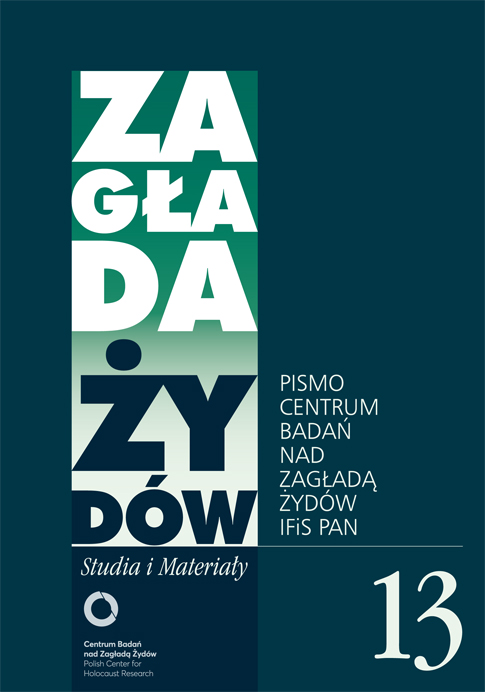Bernard Mark, powstanie w getcie warszawskim i proces Jürgena Stroopa
Zagłada Żydów. Studia i Materiały, Nr 13 (2017), Strony: 181-202
Data zgłoszenia: 2020-10-17Data publikacji: 2017-12-03
 https://doi.org/10.32927/ZZSiM.356
https://doi.org/10.32927/ZZSiM.356
Abstrakt
Jürgen Stroop, the SS general who led the liquidation of the Warsaw Ghetto and the suppression of the Warsaw Ghetto Uprising in April–May 1943, was convicted by a Polish court in 1951 and executed in 1952. Bernard (Ber) Mark (1908–1966), Holocaust historian and director of the Jewish Historical Institute in Warsaw, provided expert testimony for the prosecution at Stroop’s trial. Mark felt constrained to graft a communist-inflected narrative onto his account of the Warsaw Ghetto Uprising and to shoehorn it into his expert testimony in court and then into his interpretation of the trial for a Jewish audience. He did his best to give the Jewish Fighting Organization, which spearheaded the uprising, and its Jewish fighters their due at a time when expression of unvarnished appreciation for Jewish heroism was risky, even while he was paying overrated tribute to the communist underground for its assistance to the Jewish rebels during the uprising. But he always stopped short of the line between conformity to and defiance of the communist regime
Słowa kluczowe
Bernard Mark , Żydowski Instytut Historyczny , powstanie w getcie warszawskim , proces Jürgena Stroopa
Licencja
Prawa autorskie (c) 2017 Autor&"Zagłada Żydów. Studia i Materiały"

Utwór dostępny jest na licencji Creative Commons Uznanie autorstwa 4.0 Międzynarodowe.
https://creativecommons.org/licenses/by/4.0
Czasopismo publikowane jest w standardzie Diamond Open Access na licencji CC-BY-4.0 Deed - Uznanie autorstwa 4.0 Międzynarodowa - Creative Commons
Inne teksty tego samego autora
- Gabriel Finder, Proces Szepsla Rotholca a polityka kary w następstwie Zagłady , Zagłada Żydów. Studia i Materiały: Nr 2 (2006)
- Gabriel Finder, Svenja Bethke, Dance on the Razor’s Edge:Crime and Punishment in the Nazi Ghettos [Gabriel N. Finder] , Zagłada Żydów. Studia i Materiały: Nr 17 (2021)
Podobne artykuły
- Dariusz Libionka, Polish Church Hierarchy and the Holocaust – an Essay from a Critical Perspective , Zagłada Żydów. Studia i Materiały: 2010: Holocaust Studies and Materials
- Paweł Kosewski, Pamięć o Holokauście w kinie fabularnym (analiza retrospekcji filmowej, na podstawie filmów Pasażerka i The Pawnbroker) , Zagłada Żydów. Studia i Materiały: Nr 5 (2009)
- Aleksandra Ubertowska, Paweł Wolski, Tadeusz Borowski – Primo Levi, Prze-pisywanie literatury Holocaustu , Zagłada Żydów. Studia i Materiały: Nr 11 (2015)
- Ferenc Laczó, Dokumentując odpowiedzialność. Jenő Lévai i narodziny historiografii Zagłady na Węgrzech w latach czterdziestych XX w. , Zagłada Żydów. Studia i Materiały: Nr 10 (2014)
- Ewa Cuber-Strutyńska, Witold Pilecki. Konfrontacja z legendą o „ochotniku do Auschwitz” , Zagłada Żydów. Studia i Materiały: Nr 10 (2014)
- Dariusz Libionka, Jan Grabowski, Meldunki Obwodu „Praga” Policji Polskiej o zatrzymaniach Żydów w Warszawie w okresie maj–lipiec 1943 r. , Zagłada Żydów. Studia i Materiały: Nr 10 (2014)
- Barbara Engelking, „Niemcy zabili nam Żydów, więc wyrzucamy”. Sprawa Edwarda Toniakiewicza , Zagłada Żydów. Studia i Materiały: Nr 10 (2014)
- Katarzyna Kuczyńska-Koschany, Pustostan i jego perswazja. Język w ostatnim tekście Adolfa Hitlera , Zagłada Żydów. Studia i Materiały: Nr 10 (2014)
- Andrea Löw, Getto Litzmannstadt/Łódź pod lupą: publikacje ostatniej dekady , Zagłada Żydów. Studia i Materiały: Nr 10 (2014)
- Bartłomiej Krupa, Historia krytyczna i jej „gabinet cieni”. Historiografia polska wobec Zagłady 2003–2013 , Zagłada Żydów. Studia i Materiały: Nr 10 (2014)
<< < 15 16 17 18 19 20 21 22 23 24 25 26 27 28 29 30 31 32 33 34 35 36 37 38 39 40 41 42 43 44 45 46 47 48 > >>
Możesz również Rozpocznij zaawansowane wyszukiwanie podobieństw dla tego artykułu.
 English
English
 Język Polski
Język Polski



 https://orcid.org/0000-0003-2829-3979
https://orcid.org/0000-0003-2829-3979

